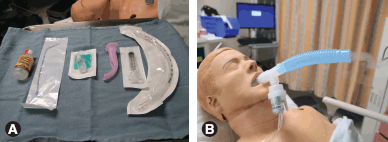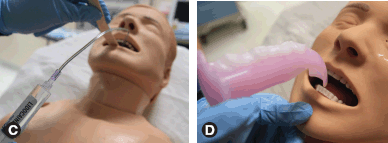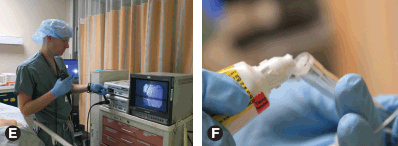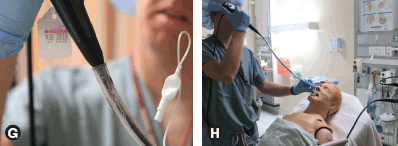Assemble equipment for airway anesthesia and intubation.
 Explain procedure and reassure patient. Sedate as appropriate. Administer nebulized lidocaine. Consider antisialogogue.
Explain procedure and reassure patient. Sedate as appropriate. Administer nebulized lidocaine. Consider antisialogogue.
A. Assemble equipment including 4% lidocaine solution, topicalization devices such as spray wand or nebulizer, oral airway, ETT and air syringe. B. Nebulized lidocaine is an effective method for topical anesthesia of the airway to tolerate awake fiberoptic intubation (FOI). Ensure total topical lidocaine does not exceed maximum dose of 5 mg/kg. Consider 0.2 mg IV glycopyrrolate antisialogogue.
 Lidocaine should also be applied directly to the airway.
Lidocaine should also be applied directly to the airway.
 Insert an oral airway. The patient should not react or “gag.”
Insert an oral airway. The patient should not react or “gag.”

C. Lidocaine should also directly to the airway with a spray wand. D. Test adequate airway topicalization by placing oral airway with lidocaine ointment. The patient should not react or “gag.”
AWAKE FIBER OPTIC INTUBATION
 Test the fiberoptic broncho scope (FOB) to ensure that it is functioning properly.
Test the fiberoptic broncho scope (FOB) to ensure that it is functioning properly.
 Remove the airway connector from the end of an ETT and apply lidocaine ointment for lubrication.
Remove the airway connector from the end of an ETT and apply lidocaine ointment for lubrication.

E. Assemble and test the FOB according to the manufacturer’s instructions. F. Remove the airway connector from the end of an ETT and apply a small amount of lidocaine ointment for lubrication so the ETT will glide smoothly over the FOB.
 Slide lubricated ETT over the FOB. Remove any excess ointment from the FOB. Consider applying anti-fog spray to FOB.
Slide lubricated ETT over the FOB. Remove any excess ointment from the FOB. Consider applying anti-fog spray to FOB.
 Elevate the head of the bed. Adjust bed height for easy positioning.
Elevate the head of the bed. Adjust bed height for easy positioning.


Full access? Get Clinical Tree







